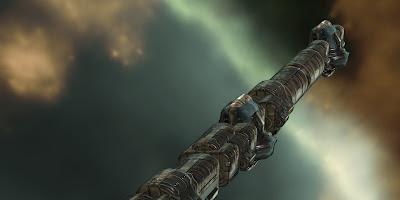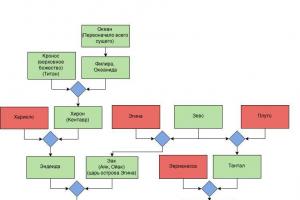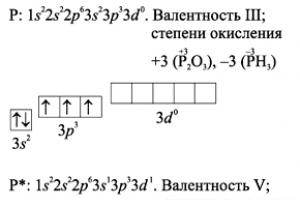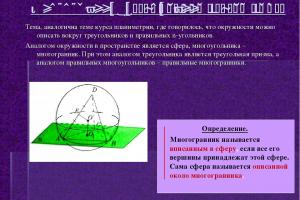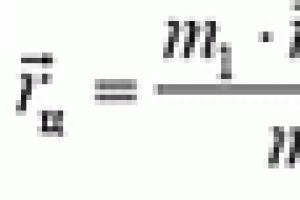Differential equations of system motion
Let us consider a system consisting of $n$ material points. Let us select some point of the system with mass $m_(k).$ We denote the resultant of all external forces applied to the point (both active and constraint reactions) by $\overline(F)_(k)^(e) $, and the resultant all internal forces - through $\overline(F)_(k)^(l) $. If the point has an acceleration $\overline(a_(k) )$, then according to the basic law of dynamics:
We get a similar result for any point. Therefore, for the entire system it will be:
Equations (1) are differential equations of motion of the system in vector form.
Projecting equalities (1) onto the coordinate axes, we obtain the equations of motion of the system in differential form in projections onto these axes.
However, when solving many specific problems, the need to find the law of motion for each of the points of the system does not arise, but sometimes it is enough to find the characteristics that determine the motion of the entire system as a whole.
Theorem on the motion of the center of mass of the system
To determine the nature of the motion of a system, it is necessary to know the law of motion of its center of mass. The center of mass or center of inertia of a system is such an imaginary point, the radius vector $R$ of which is expressed through the radius vectors $r_(1) ,r_(2) ,...$of material points according to the formula:
$R=\frac(m_(1) r_(1) +m_(2) r_(2) +...+m_(n) r_(n) )(m) $, (2)
where $m=m_(1) +m_(2) +...+m_(n) $ is the total mass of the entire system.
To find this law, let us turn to the equations of motion of system (1) and add their left and right sides term by term. Then we get:
$\sum m_(k) \overline(a)_(k) =\sum \overline(F)_(k)^(e) +\sum \overline(F)_(k)^(l) $. (3)
From formula (2) we have:
Taking the second derivative with respect to time, we get:
$\sum m_(k) \overline(a)_(k) =M\overline(a)_(c) $, (4)
where $\overline(a)_(c) $ is the acceleration of the center of mass of the system.
Since, by the property of internal forces in the system, $\sum \overline(F)_(k)^(l) =0$, we finally obtain from equality (3), taking into account (4):
$M\overline(a)_(c) =\sum \overline(F)_(k)^(e) $. (5)
Equation (5) expresses the theorem on the motion of the center of mass of the system: the product of the mass of the system and the acceleration of its center of mass is equal to the geometric sum of all external forces acting on the system, or the center of mass of the system moves like a material point, the mass of which is equal to the mass of the entire system and to which all external forces are applied forces acting on the system.
Projecting both sides of equality (5) onto the coordinate axes, we obtain:
$M\ddot(x)_(c) =\sum \overline(F)_(kx)^(e) $, $M\ddot(y)_(c) =\sum \overline(F)_( ky)^(e) $, $M\ddot(z)_(c) =\sum \overline(F)_(kz)^(e) $. (6)
These equations are differential equations of motion of the center of mass in projections on the axes of the Cartesian coordinate system.
The meaning of the theorem is as follows:
Theorem
- A forward moving body can always be considered as a material point with a mass equal to the mass of the body. In other cases, the body can be considered as a material point only when, in practice, to determine the position of the body it is enough to know the position of its center of mass and it is permissible, according to the conditions of the problem, not to take into account the rotational part of the body’s movement;
- The theorem allows us to exclude from consideration all previously unknown internal forces. This is its practical value.
Example
A metal ring suspended on a thread to the axis of a centrifugal machine rotates uniformly with an angular velocity $\omega $. The thread makes an angle $\alpha $ with the axis. Find the distance from the center of the ring to the axis of rotation.
\[\omega \] \[\alpha \]
Our system is affected by the force of gravity $\overline(N)$ $\overline(N)$ $\alpha \alpha$, the tension force of the thread and centripetal acceleration.
Let's write down Newton's second law for our system:
Let's project both parts onto the x and y axes:
\[\left\( \begin(array)(c) N\sin \alpha =ma; \\ N\cos \alpha =mg; \end(array) \right.(4)\]
Dividing one equation by the other, we get:
Since $a=\frac(v^(2) )(R) ;$$v=\omega R$, we find the required distance:
Answer: $R=\frac(gtg\alpha )(\omega ^(2) ) $
By special agreement with the editorial board and editors of the journal “Kvant”
When solving mechanical problems, the use of the concept of the center of mass of a system of material points can provide invaluable assistance. Some problems simply cannot be solved without resorting to this concept; solving others with its help can become much simpler and more clear.
Before discussing specific problems, let us recall the basic properties of the center of mass and illustrate them with examples.
The center of mass (center of inertia) of a system of material points is a point that characterizes the distribution of masses in the system, the coordinates of which are determined by the formulas
Here m i- masses of material points forming the system, x i, y i, z i- coordinates of these points. Readers familiar with the concept of a radius vector will prefer the vector notation:
![]() (1)
(1)
Example 1. Let us find the position of the center of mass, the simplest system consisting of two points whose masses m 1 and m 2 and the distance between them l(Fig. 1).

Directing the axis X from the first point to the second, we find that the distance from the first point to the center of mass (i.e., the coordinate of the center of mass) is equal to and the distance from the center of mass to the second point is equal to i.e. the ratio of distances is inverse to the ratio of masses. This means that in this case the position of the center of mass coincides with the center of gravity.
Let us discuss some properties of the center of mass, which, it seems to us, will fill the somewhat formal definition of this concept given above with physical content.
1) The position of the center of mass will not change if some part of the system is replaced by one point with a mass equal to the mass of this subsystem and located at its center of mass.
Example 2. Let's consider a flat homogeneous triangle and find the position of its center of mass. Divide the triangle into thin strips parallel to one of the sides, and replace each strip with a point located in its middle. Since all such points lie on the median of the triangle, the center of mass must also lie on the median. Repeating the reasoning for each side, we find that the center of mass is at the intersection of the medians.
2) The speed of the center of mass can be found by taking the time derivative of both sides of equality (1):
![]() (2)
(2)
Where - system impulse, m- total mass of the system. It can be seen that the speed of the center of mass of the closed system is constant. This means that if we associate a translationally moving reference frame with the center of mass, then it will be inertial.
Example 3. Let us place a uniform rod of length l vertically onto a smooth plane (Fig. 2) and release. During the fall, both the horizontal component of its momentum and the horizontal component of the velocity of the center of mass will remain equal to zero. Therefore, at the moment of the fall, the center of the rod will be in the place where the rod originally stood, and the ends of the rod will shift horizontally by .

3) The acceleration of the center of mass is equal to the derivative of its speed with respect to time:
![]() (3)
(3)
where on the right side of the equality there are only external forces, since all internal forces cancel according to Newton’s third law. We find that the center of mass moves as an imaginary point with a mass equal to the mass of the system would move under the action of the resulting external force. This is probably the most physical property of the center of mass.
Example 4. If you throw a stick, causing it to rotate, then the center of mass of the stick (its middle) will move with constant acceleration along a parabola (Fig. 3).

4) Let the system of points be in a uniform gravitational field. Then the total moment of gravity relative to any axis passing through the center of mass is equal to zero. This means that the resultant of gravity passes through the center of mass, i.e. the center of mass is also the center of gravity.
5) The potential energy of a system of points in a uniform gravitational field is calculated by the formula

Where h ts - height of the system's center of mass.
Example 5. When digging a hole in a uniform pound deep h and scattering of soil over the surface, its potential energy increases by , where m- mass of excavated soil.
6) And one more useful property of the center of mass. The kinetic energy of a system of points can be represented as the sum of two terms: the kinetic energy of the general translational motion of the system, equal to , and the kinetic energy E relative to the motion relative to the reference system associated with the center of mass:
![]()
Example 6. The kinetic energy of a hoop rolling without slipping on a horizontal surface with a speed υ is equal to
![]()
since the relative motion in this case is pure rotation, for which the linear speed of the points of the hoop is equal to υ (the total speed of the lower point must be equal to zero).
Now let's start analyzing problems using the center of mass.
Problem 1. A homogeneous rod lies on a smooth horizontal surface. Two horizontal forces of equal magnitude but opposite in direction are applied to the rod: one force is applied to the middle of the rod, the other to its end (Fig. 4). Relative to what point will the rod begin to rotate?

At first glance, it may seem that the axis of rotation will be the point lying in the middle between the points of application of forces. However, equation (3) shows that since the sum of the external forces is zero, the acceleration of the center of mass is also zero. This means that the center of the rod will remain at rest, i.e. serve as an axis of rotation.
Problem 2. Thin uniform rod length l and mass m set in motion along a smooth horizontal surface so that it moves translationally and simultaneously rotates with angular velocity ω. Find the tension of the rod depending on the distance x to its center.
Let us move to the inertial reference system associated with the center of the rod. Let us consider the movement of a piece of a rod enclosed between the point of the rod under consideration (located at a distance x from the center) and its end (Fig. 5).

The only external force for this piece is the required tension force F n, the mass is equal to , and its center of mass moves in a circle of radius ![]() with acceleration. Writing down the equation of motion of the center of mass of the selected piece, we obtain
with acceleration. Writing down the equation of motion of the center of mass of the selected piece, we obtain
![]()
Problem 3. A binary star consists of two component stars with masses m 1 and m 2, the distance between which does not change and remains equal L. Find the rotation period of the binary star.
Let us consider the motion of the component stars in an inertial frame of reference associated with the center of mass of the binary star. In this reference frame, stars move with the same angular velocity along circles of different radii (Fig. 6).

Radius of rotation of a star with mass m 1 is equal (see Example 1), and its centripetal acceleration is created by the force of attraction towards another star:
![]()
We see that the rotation period of a double star is equal to
![]()
and is determined by the total mass of the binary star, regardless of how it is distributed among the component stars.
Problem 4. Two point masses m and 2 m tied with a weightless thread length l and move along a smooth horizontal plane. At some point in time the speed of mass 2 m is equal to zero, and the mass velocity m equal to υ and directed perpendicular to the thread (Fig. 7). Find the thread tension and the rotation period of the system.

Rice. 7
The center of mass of the system is at a distance from mass 2 m and moves with speed. In the reference system associated with the center of mass, a point of mass 2 m moves in a circle of radius with speed . This means that the rotation period is equal to (check that the same answer is obtained if we consider a point with mass m). We find the thread tension from the equation of motion of any of the two points:

Problem 5. Two identical blocks of mass m each connected by a light spring stiffness k(Fig. 8). The first bar is given a speed υ 0 in the direction from the second bar. Describe the motion of the system. How long will it take for the spring deformation to reach its maximum value for the first time?
![]()
The center of mass of the system will move at a constant speed. In the reference frame of the center of mass, the initial speed of each block is , and the stiffness of the half spring that connects it to the stationary center of mass is 2 k(the spring stiffness is inversely proportional to its length). The period of such oscillations is equal to
and the amplitude of vibration of each bar, which can be found from the law of conservation of energy, is
For the first time, the deformation will become maximum after a quarter of the period, i.e. after a while .
Problem 6. Ball mass m impinges with speed v on a stationary ball of mass 2 m. Find the velocities of both balls after the elastic central impact.
In the reference frame associated with the center of mass, the total momentum of the two balls is zero both before and after the collision. It is easy to guess which answer for final velocities satisfies both this condition and the law of conservation of energy: the velocities will remain the same in magnitude as before the impact, but will change their directions to the opposite. The speed of the center of mass of the system is equal to . In the center of mass system, the first ball moves with speed , and the second ball moves towards the first with speed . After the impact, the balls will fly away at the same speeds. It remains to return to the original frame of reference. Applying the law of addition of velocities, we find that the final speed of a ball with mass m equal and directed backward, and the speed of the previously at rest ball of mass 2 m equal and directed forward.
Note that in the center of mass system it is obvious that upon impact the relative speed of the balls does not change in magnitude, but changes in direction. And since the difference in speeds does not change when moving to another inertial reference system, we can assume that we have derived this important relation for the original reference system:
υ 1 – υ 2 = u 1 – u 2 ,
where the letter υ is used to denote initial velocities, and u- for the final ones. This equation can be solved together with the law of conservation of momentum instead of the law of conservation of energy (where velocities come in to the second power).
Problem 7. It is known that during an elastic off-center impact of two identical balls, one of which was at rest before the impact, the angle of expansion is 90°. Prove this statement.
In the center of mass system, an off-center impact can be described as follows. Before the impact, the balls approach with equal impulses; after the impact, they fly apart with impulses of the same magnitude, but in opposite directions, and the line of expansion rotates at a certain angle relative to the line of approach. To go back to the initial frame of reference, each final velocity must be added (vectorally!) with the velocity of the center of mass. In the case of identical balls, the speed of the center of mass is equal to , where υ is the speed of the incident ball, and in the reference frame of the center of mass, the balls approach and fly apart at the same speeds. The fact that after adding each final velocity to the velocity of the center of mass, mutually perpendicular vectors are obtained can be seen from Figure 9. Or you can simply check that the scalar product of vectors and vanishes due to the fact that the modules of the vectors are equal to each other.

Exercises
1. Rod of mass m and length l hinged at one end. The rod was deflected at a certain angle from the vertical position and released. At the moment of passing the vertical position, the speed of the lower point is equal to υ. Find the tension at the midpoint of the rod at this point in time.
2. Rod of mass m and length l rotate in a horizontal plane with angular velocity ω around one of its ends. Find the relationship between the tension of the rod and the distance x to the axis of rotation, if a small weight of mass is attached to the other end M.
3. Find the period of oscillation for the system described in problem 5 of the article, but for bars of different masses m 1 and m 2 .
4. Derive the known general formulas for the elastic central impact of two balls, using the transition to the center of mass reference frame.
5. Ball of mass m 1 collides with a ball at rest of lesser mass m 2. Find the maximum possible angle of deflection of the incoming ball during an elastic off-center impact.
1. ![]()
2. ![]()
3. ![]()
When we are dealing with a system of particles, it is convenient to find a point - the center of mass - that would characterize the position and movement of this system as a whole. In a system of two identical particles, such a point C obviously lies in the middle between them (Fig. 110a). This is clear from considerations of symmetry: in a homogeneous and isotropic space, this point is distinguished from all others, because for any other point A located closer to one of the particles, there is a point B symmetrical to it, located closer to the second particle.
Rice. 110. The center of mass of two identical particles is at point C with radius vector ; the center of mass of two particles with different masses divides the segment between them in a ratio inversely proportional to the masses of the particles (b)
Obviously, the radius vector of point C is equal to half the sum of the radius vectors of identical particles (Fig. 110a): In other words, it is the usual average value of the vectors
Determination of the center of mass. How to generalize this definition to the case of two particles with different masses It can be expected that, along with the geometric center of the system, the radius vector of which is still equal to half the sum, a point will play a certain role, the position of which is determined by the distribution
I eat mass. It is natural to define it so that the contribution of each particle is proportional to its mass:
![]()
The radius vector of the center of mass, determined by formula (1), is the weighted average value of the radius vectors of particles, which is obvious if we rewrite (1) in the form
![]()
The radius vector of each particle enters with a weight proportional to its mass. It is easy to see that the center of mass C, determined by formula (1), lies on the straight line segment connecting the particles and divides it in a ratio inversely proportional to the masses of the particles: (Fig. 110b).
Please note that the definition of the center of mass given here is related to the condition of equilibrium of the lever, which you know. Let us imagine that point masses, which are subject to the action of a uniform gravitational field, are connected by a rod of negligible mass. Such a lever will be in equilibrium if its fulcrum is placed at the center of mass C.
A natural generalization of formula (1) to the case of a system consisting of material points with masses and radius vectors is the equality
which serves as a definition of the radius vector of the center of mass (or center of inertia) of the system.
Speed of the center of mass. The center of mass characterizes not only the position, but also the movement of the system of particles as a whole. The velocity of the center of mass, determined by the equality as follows from (2), is expressed as follows in terms of the velocities of the particles forming the system:

The numerator on the right side of this expression, as follows from formula (6) of the previous paragraph, contains the total momentum of the system P, and the denominator is its total mass M. Therefore, the momentum of the particle system is equal to the product of the mass of the entire system M and the speed of its center of mass

Formula (4) shows that the momentum of a system is related to the velocity of its center of mass in the same way as the momentum of an individual particle is related to the velocity of the particle. It is in this sense that the movement of the center of mass characterizes the movement of the system as a whole.
Law of motion of the center of mass. The law of change in the momentum of a system of particles, expressed by formula (9) of the previous paragraph, is essentially the law of motion of its center of mass. In fact, from (4) with a constant total mass M of the system we have
![]()
which means that the rate of change of momentum of the system is equal to the product of its mass and the acceleration of the center of mass. Comparing (5) with formula (6) § 29, we obtain

According to (6), the center of mass of the system moves as one material point of mass M would move under the influence of a force equal to the sum of all external forces acting on the particles entering the system. In particular, the center of mass of a closed physical system, which is not acted upon by external forces, moves uniformly and rectilinearly in the inertial frame of reference or is at rest.
The idea of the center of mass in a number of cases makes it possible to obtain answers to some questions even more simply than by directly using the law of conservation of momentum. Consider the following example.
An astronaut outside the ship. A mass cosmonaut, stationary relative to the mass spacecraft with the engine turned off, begins to pull himself towards the ship using a light safety cord. What distances will the astronaut and the spacecraft travel before meeting if the initial distance between them is
The center of mass of the ship and the astronaut is located on the straight line connecting them, and the corresponding distances are inversely proportional to the masses. Since then
we get it right away
![]()
In deep space, where there are no external forces, the center of mass of this closed system is either at rest or moving at a constant speed. In the reference frame where he is at rest, the astronaut and the ship will travel the distances given by formulas (7) before meeting.
For the validity of such reasoning, it is fundamentally important to use an inertial frame of reference. If here we had recklessly connected the reference system with the spaceship, we would have come to the conclusion that when the astronaut is pulled up, the center of mass of the system begins to move in the absence of external forces: he approaches the ship. The center of mass maintains its speed only relative to the inertial reference frame.
Equation (6), which determines the acceleration of the center of mass of a particle system, does not include the internal forces acting in it. Does this mean that internal forces have no effect on the movement of the center of mass at all? In the absence of external forces or when these forces are constant, this is indeed the case. For example, in a uniform field of gravity, the center of mass of a projectile that exploded in flight continues to move along the same parabola until none of the fragments have yet fallen to the ground.
The role of internal forces. In cases where external forces can change, the situation is somewhat more complicated. External forces act not on the center of mass, but on individual particles of the system. These forces can depend on the position of the particles, and the position of each particle during its movement is determined by all the forces acting on it, both external and internal.
Let us explain this using the same simple example of a projectile that breaks into small fragments in flight under the influence of internal forces. While all the fragments are in flight, the center of mass, as already mentioned, continues to move along the same parabola. However, as soon as at least one of the fragments touches the ground and its movement stops, a new external force will be added - the reaction force of the earth's surface acting on the fallen fragment. As a result, the acceleration of the center of mass will change, and it will no longer move along the same parabola. The very appearance of this reaction force is a consequence of the action of internal forces that exploded the projectile. So, the action of internal forces at the moment the projectile breaks can lead to a change in the acceleration with which the center of mass will move at later times and, consequently, to a change in its trajectory.
Let us give an even more striking example of the influence of internal forces on the movement of the center of mass. Let's imagine that the Earth's satellite,
revolving around it in a circular orbit, under the influence of internal forces it is divided into two halves. One of the halves stops and begins to fall vertically to the Earth. According to the law of conservation of momentum, the second half must at this moment double its speed, directed tangentially to the circle. As we will see below, at such a speed this half will fly away from the Earth to an infinitely large distance. Consequently, the center of mass of the satellite, i.e., its two halves, will also move to an infinitely large distance from the Earth. And the reason for this is the action of internal forces when the satellite is divided into two parts, since otherwise the undivided satellite would continue to move in a circular orbit.
Jet propulsion. The law of conservation of momentum of a closed system makes it easy to explain the principle of reactive motion. When fuel is burned, the temperature rises and high pressure is created in the combustion chamber, due to which the resulting gases escape from the rocket engine nozzle at high speed. In the absence of external fields, the total momentum of the rocket and the gases escaping from the nozzle remains unchanged. Therefore, when the gases flow out, the rocket acquires speed in the opposite direction.
Meshchersky equation. We obtain an equation describing the motion of the rocket. Let at some moment of time the rocket in some inertial frame of reference have a speed. Let us introduce another inertial frame of reference, in which at a given moment of time the rocket is motionless. Let us call such a reference system comoving. If a working rocket engine ejects mass gases at a speed relative to the rocket over a period of time, then after a while the rocket’s speed in this accompanying system will be different from zero and equal to
Let us apply the law of conservation of momentum to the closed physical system under consideration, a rocket plus gases. At the initial moment, in the accompanying frame of reference, the rocket and gases are at rest, so the total momentum is zero. After time, the momentum of the rocket is equal to the momentum of the ejected gases. Therefore
The total mass of the rocket system plus gases is conserved, so the mass of ejected gases is equal to the loss of rocket mass:
![]()
Now equation (8) after dividing by a period of time is rewritten as
![]()
Moving to the limit, we obtain the equation of motion of a body of variable mass (rocket) in the absence of external forces:
![]()
Equation (9) has the form of Newton’s second law, if its right side is considered as a reactive force, i.e., the force with which the gases escaping from it act on the rocket. The mass of the rocket here is not constant, but decreases over time due to the loss of matter, i.e. Therefore, the reactive force; directed in the direction opposite to the speed of the gases escaping from the nozzle relative to the rocket. It can be seen that this force is greater, the higher the speed of gas flow and the higher the fuel consumption per unit time.
Equation (9) was obtained in a certain inertial reference system - the accompanying system. Due to the principle of relativity, it is also true in any other inertial frame of reference. If, in addition to the reactive force, any other external forces act on the rocket, such as gravity and air resistance, then they should be added to the right side of equation (9):
![]()
This equation was first obtained by Meshchersky and bears his name. For a given engine operating mode, when the mass is a certain known function of time, the Meshchersky equation allows you to calculate the speed of the rocket at any time.
What physical considerations indicate the advisability of determining the center of mass using formula (1)?
In what sense does the center of mass characterize the movement of a system of particles as a whole?
What does the law of motion of the center of mass of a system of interacting bodies say? Do internal forces affect the acceleration of the center of mass?
Can internal forces influence the trajectory of the system's center of mass?
In the problem of a projectile bursting, considered in the previous paragraph, the law of motion of the center of mass allows us to immediately find the flight range of the second fragment if its initial speed is horizontal. How to do it? Why do these considerations not apply in the case where its initial velocity has a vertical component?
During the acceleration of a rocket, its engine operates in a constant mode, so that the relative speed of gas flow and fuel consumption per unit time are constant. Will the acceleration of the rocket be constant?
Derive the Meshchersky equation using, instead of a comoving reference frame, an inertial frame in which the rocket already has speed
Tsiolkovsky's formula. Let us assume that the rocket accelerates in free space, where no external forces act on it. As fuel is consumed, the mass of the rocket decreases. Let's find the relationship between the mass of fuel consumed and the speed gained by the rocket.
After turning on the engine, the stationary rocket begins to pick up speed, moving in a straight line. Projecting the vector equation (9) onto the direction of motion of the rocket, we obtain
![]()
In equation (11), we will consider the mass of the rocket as a function of the speed gained by the rocket. Then the rate of change of mass over time can be represented as follows:
![]()
Center of mass Equation of motion of the center of mass. The law itself: Bodies act on each other with forces of the same nature directed along the same straight line, equal in magnitude and opposite in direction: The center of mass is a geometric point characterizing the movement of a body or a system of particles as a whole. Definition The position of the center of mass of the center of inertia in classical mechanics is defined as follows: where the radius vector of the center of mass is the radius vector of the ith point of the system and the mass of the ith point.
7.Newton's third law. Center of mass Equation of motion of the center of mass.
Newton's third lawstates: the action force is equal in magnitude and opposite in direction to the reaction force.
The law itself:
Bodies act on each other with forces of the same nature, directed along the same straight line, equal in magnitude and opposite in direction:
Center of mass this is a geometric point characterizing movement body or system of particles as a whole.
Definition
The position of the center of mass (center of inertia) in classical mechanics is determined as follows:
 where radius vector of the center of mass, radius vector i th point of the system,
where radius vector of the center of mass, radius vector i th point of the system,
mass of the i-th point.
 .
.
This is the equation of motion of the center of mass of a system of material points with a mass equal to the mass of the entire system, to which the sum of all external forces is applied (the main vector of external forces) or the theorem on the motion of the center of mass.
As well as other works that may interest you |
|||
| 22476. | CLASSIFICATION OF PERSONAL RADIO CALL SYSTEMS, PAGERS, REPEATERS, BASIC INFORMATION TRANSMISSION PROTOCOLS. | 1.21 MB | |
| CLASSIFICATION OF PERSONAL RADIO CALL SYSTEMS PAGERS REPEATERS BASIC INFORMATION TRANSMISSION PROTOCOLS. Purpose of the work To study the classification of personal radio call systems, pagers, repeaters, basic information transfer protocols. Familiarize yourself with the basic protocols for transmitting information to the SPRV. In this case, to transfer the call to the subscriber, sequential tone coding of the address was used, providing the ability to service up to several tens of thousands of users. | |||
| 22477. | STUDYING METHODS OF CODING SPEECH SIGNALS IN THE TETRA TRUNKING NETWORKS STANDARD | 961.5 KB | |
| Task: Familiarize yourself with the general description of the speech signal coding algorithm. Study the features of channel coding for various logical channels. General description of the CELP speech signal coding algorithm To encode information multiplexing of speech signals, the TETRA standard uses an encoder with linear prediction and multi-pulse excitation from the CELP Code Code Excited Linear Pgediction. | |||
| 22478. | GSM-900 CELLULAR COMMUNICATION SYSTEM | 109.5 KB | |
| Purpose of the work To study the main technical characteristics of the functional structure and interfaces adopted in the digital cellular mobile radio communication system of the GSM standard. Task: Familiarize yourself with the general characteristics of the GSM standard. Brief theory The GSM Global System for Mobile communications standard is closely related to all modern digital network standards, primarily ISDN and IN Intelligent Network. | |||
The center of mass of the system is the point with the radius vector
For a continuous distribution of mass with density  . If the gravitational forces applied to each particle of the system are directed one way, then the center of mass coincides with the center of gravity. But if
. If the gravitational forces applied to each particle of the system are directed one way, then the center of mass coincides with the center of gravity. But if  not parallel, then the center of mass and the center of gravity do not coincide.
not parallel, then the center of mass and the center of gravity do not coincide.
Taking the time derivative of  , we get:
, we get:

those. the total momentum of the system is equal to the product of its mass and the speed of the center of mass.
Substituting this expression into the law of change in total momentum, we find:

The center of mass of the system moves like a particle in which the entire mass of the system is concentrated and to which the resulting mass is applied external strength
At progressive In motion, all points of a rigid body move in the same way as the center of mass (along the same trajectories), therefore, to describe translational motion, it is enough to write down and solve the equation of motion of the center of mass.
Because  , then the center of mass closed system must maintain a state of rest or uniform linear motion, i.e.
, then the center of mass closed system must maintain a state of rest or uniform linear motion, i.e.  =const. But at the same time, the entire system can rotate, fly apart, explode, etc. as a result of action internal forces.
=const. But at the same time, the entire system can rotate, fly apart, explode, etc. as a result of action internal forces.
Jet propulsion. Meshchersky equation
Reactive called the movement of a body in which it occurs accession or discarding masses. During the process of movement, a change in the mass of the body occurs: during the time dt, a body of mass m attaches (absorbs) or rejects (emits) mass dm with a speed  relative to the body; in the first case dm>0, in the second dm<0.
relative to the body; in the first case dm>0, in the second dm<0.
Let's consider this movement using the example of a rocket. Let us move to the inertial reference frame K", which at a given moment of time t is moving at the same speed  , the same as a rocket - this is called an ISO accompanying– in this frame of reference the rocket is currently t rests(rocket speed in this system
, the same as a rocket - this is called an ISO accompanying– in this frame of reference the rocket is currently t rests(rocket speed in this system  =0). If the sum of external forces acting on the rocket is not equal to zero, then the equation of motion of the rocket in the K system, but since all ISOs are equivalent, then in the K system the equation will have the same form:
=0). If the sum of external forces acting on the rocket is not equal to zero, then the equation of motion of the rocket in the K system, but since all ISOs are equivalent, then in the K system the equation will have the same form:

This - Meshchersky equation, describing the movement any body with variable mass).
In the equation, mass m is a variable quantity, and it cannot be included under the derivative sign. The second term on the right side of the equation is called reactive force

For a rocket, the reactive force plays the role of a traction force, but in the case of adding mass dm/dt>0, the reactive force will also be a braking force (for example, when a rocket is moving in a cloud of cosmic dust).
Energy of a particle system
The energy of a particle system consists of kinetic and potential. The kinetic energy of a system is the sum of the kinetic energies of all particles in the system

and is, according to definition, the quantity additive(like impulse).
The situation is different with the potential energy of the system. Firstly, interaction forces act between the particles of the system  . ThereforeA ij =-dU ij, where U ij is the potential energy of interaction between the i-th and j-th particles. Summing U ij over all particles of the system, we find the so-called own potential energy systems:
. ThereforeA ij =-dU ij, where U ij is the potential energy of interaction between the i-th and j-th particles. Summing U ij over all particles of the system, we find the so-called own potential energy systems:

It is essential that the system's own potential energy depends only on its configuration. Moreover, this quantity is not additive.
Secondly, each particle of the system, generally speaking, is also affected by external forces. If these forces are conservative, then their work will be equal to the decrease in external potential energy A=-dU ext, where

where U i is the potential energy of the i-th particle in an external field. It depends on the positions of all particles in the external field and is additive.
Thus, the total mechanical energy of a particle system located in an external potential field is defined as
E syst =K syst +U int +U ext

